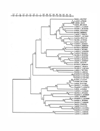A phylogenetic study of cytochrome b561 proteins
- PMID: 12801412
- PMCID: PMC193617
- DOI: 10.1186/gb-2003-4-6-r38
A phylogenetic study of cytochrome b561 proteins
Abstract
Background: As an antioxidant and cofactor to numerous metabolic enzymes, ascorbate has an essential role in plants and animals. Cytochromes b561 constitute a class of intrinsic membrane proteins involved in ascorbate regeneration. Despite their importance in ascorbate metabolism, no evolutionary analysis has been presented so far on this newly described protein family.
Results: Cytochromes b561 have been identified in a large number of phylogenetically distant species, but are absent in fungi and prokaryotes. Most species contain three or four cytochrome b561 paralogous proteins, and the encoding genes usually have four or five exons. At the protein level, sequence similarities are rather low between cytochromes b561 within a single species (34-45% identity), and among phylogenetically distant species (around 30% identity). However, particular structural features characterizing this protein family are well conserved in members from all species investigated. These features comprise six transmembrane helices, four strictly conserved histidine residues, probably coordinating the two heme molecules, and putative ascorbate and monodehydro-ascorbate (MDHA) substrate-binding sites. Analysis of plant cytochromes b561 shows a separation between those from monocotyledonous and dicotyledonous species in a phylogenetic tree.
Conclusions: All cytochromes b561 have probably evolved from a common ancestral protein before the separation of plants and animals. Their phyletic distribution mirrors the use of ascorbate as primary antioxidant, indicating their role in ascorbate homeostasis and antioxidative defense. In plants, the differentiation into four cytochrome b561 isoforms probably occurred before the separation between monocots and dicots.
Figures





Similar articles
-
Higher-plant plasma membrane cytochrome b561: a protein in search of a function.Protoplasma. 2001;217(1-3):77-93. doi: 10.1007/BF01289417. Protoplasma. 2001. PMID: 11732342 Review.
-
An Arabidopsis cytochrome b561 with trans-membrane ferrireductase capability.FEBS Lett. 2007 Apr 3;581(7):1505-8. doi: 10.1016/j.febslet.2007.03.006. Epub 2007 Mar 12. FEBS Lett. 2007. PMID: 17376442
-
Identification of an ascorbate-dependent cytochrome b of the tonoplast membrane sharing biochemical features with members of the cytochrome b561 family.Planta. 2005 Jan;220(3):365-75. doi: 10.1007/s00425-004-1360-0. Epub 2004 Sep 9. Planta. 2005. PMID: 15365836
-
Cytochrome b561 protein family: expanding roles and versatile transmembrane electron transfer abilities as predicted by a new classification system and protein sequence motif analyses.Biochim Biophys Acta. 2005 Dec 1;1753(2):174-90. doi: 10.1016/j.bbapap.2005.08.015. Epub 2005 Sep 7. Biochim Biophys Acta. 2005. PMID: 16169296
-
Cytochrome b561, ascorbic acid, and transmembrane electron transfer.Am J Clin Nutr. 1991 Dec;54(6 Suppl):1173S-1178S. doi: 10.1093/ajcn/54.6.1173s. Am J Clin Nutr. 1991. PMID: 1962566 Review.
Cited by
-
Lysosomal iron recycling in mouse macrophages is dependent upon both LcytB and Steap3 reductases.Blood Adv. 2022 Mar 22;6(6):1692-1707. doi: 10.1182/bloodadvances.2021005609. Blood Adv. 2022. PMID: 34982827 Free PMC article.
-
Expression profile of Caenorhabditis elegans mutant for the Werner syndrome gene ortholog reveals the impact of vitamin C on development to increase life span.BMC Genomics. 2014 Oct 27;15(1):940. doi: 10.1186/1471-2164-15-940. BMC Genomics. 2014. PMID: 25346348 Free PMC article.
-
Auxin-responsive genes AIR12 code for a new family of plasma membrane b-type cytochromes specific to flowering plants.Plant Physiol. 2009 Jun;150(2):606-20. doi: 10.1104/pp.109.139170. Epub 2009 Apr 22. Plant Physiol. 2009. PMID: 19386804 Free PMC article.
-
nemy encodes a cytochrome b561 that is required for Drosophila learning and memory.Proc Natl Acad Sci U S A. 2008 Dec 16;105(50):19986-91. doi: 10.1073/pnas.0810698105. Epub 2008 Dec 8. Proc Natl Acad Sci U S A. 2008. PMID: 19064935 Free PMC article.
-
Tuning of the thermochemical and kinetic properties of ascorbate by its local environment: solution chemistry and biochemical implications.J Am Chem Soc. 2010 Jun 9;132(22):7784-93. doi: 10.1021/ja102337n. J Am Chem Soc. 2010. PMID: 20476757 Free PMC article.
References
-
- Arrigoni O, De Tullio MC. The role of ascorbic acid in cell metabolism: between gene-directed functions and unpredictable chemical reactions. J Plant Physiol. 2000;157:481–488.
-
- Davey MW, Van Montagu M, Inze D, Sanmartin M, Kanellis A, Smirnoff N, Benzie IJJ, Strain JJ, Favell D, Fletcher J. Plant L-ascorbic acid: chemistry, function, metabolism, bioavailability and effects of processing. J Sci Food Agricult. 2000;80:825–860. doi: 10.1002/(SICI)1097-0010(20000515)80:7<825::AID-JSFA598>3.3.CO;2-Y. - DOI
Publication types
MeSH terms
Substances
LinkOut - more resources
Full Text Sources
Molecular Biology Databases
Research Materials
Miscellaneous

